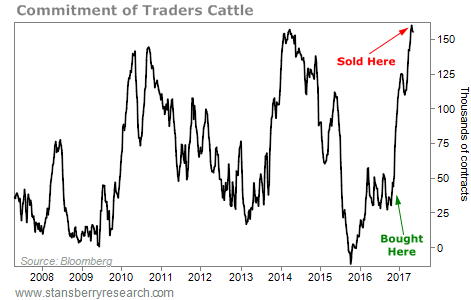Last month, my True Wealth readers closed what I called the “Bacon Cheeseburger Trade” for a 26% gain in just six months.
We bought for a specific reason, as I’ll show today. And because of that, we stuck to our discipline. We followed the most important rule in finance and investing…
[ad#Google Adsense 336×280-IA]That is, when the facts changed, we changed our minds.
That’s an important lesson. So let me share the details with you…
The “Bacon Cheeseburger Trade” was a simple bet.
We were betting on higher prices for the components of a bacon cheeseburger… cattle and hogs. Here’s what the story looked like seven months ago…
Hog prices were down 69% from their peak in 2014. And cattle prices were down 41% from their highs. It was the biggest fall in cattle prices ever, with data going back more than 50 years.
Fear was high in the cattle and hog markets. And if you’re a longtime reader, you know that’s just what we want to see.
When I recommended the trade, I said I didn’t pretend to know anything about the cattle or hog markets. Hogs and cattle were cheap and hated… That was about all I needed to know.
But the story changed… So I changed my mind.
Cattle prices soared. A blizzard squeezed production by killing cattle throughout the Midwest, causing a supply shortage.
Cattle prices moved higher… And sentiment went from negative to positive.
To gauge sentiment in a given asset class, we look at the Commitment of Traders (“COT”) report, a measure of what futures traders are betting on. Sentiment for cattle prices hit its highest level since 2014… and its second-highest level in a quarter century. Take a look:
 The only other time futures traders were even close to today’s bullish extreme was in 2014. And what happened back then wasn’t pretty…
The only other time futures traders were even close to today’s bullish extreme was in 2014. And what happened back then wasn’t pretty…
Cattle prices peaked shortly after that… and entered a multiyear bear market. The commodity fell more than 40% from its 2014 highs to its 2016 low.
That was a dramatic fall. And after earning healthy profits, we were looking at the potential for a similar decline.
My original plan was to sell half of our position once we were up 25% and then sell the other half when it was up 50%. But the facts changed – so we changed our plan.
Sure, prices could have gone higher in the short term. But with extreme optimism, our upside was limited… And our downside risk was large.
The reason we bought was gone… We were sitting on healthy profits… And the risks in our trade had ballooned.
In other words, the facts changed, so we changed our minds.
You should always know why you’re making a trade. And if you find that your reason no longer exists… it’s time to get out.
This is the most important rule of finance and investing. Make sure you’re following it in your own portfolio.
Good investing,
Steve
[ad#stansberry-ps]
Source: Daily Wealth
